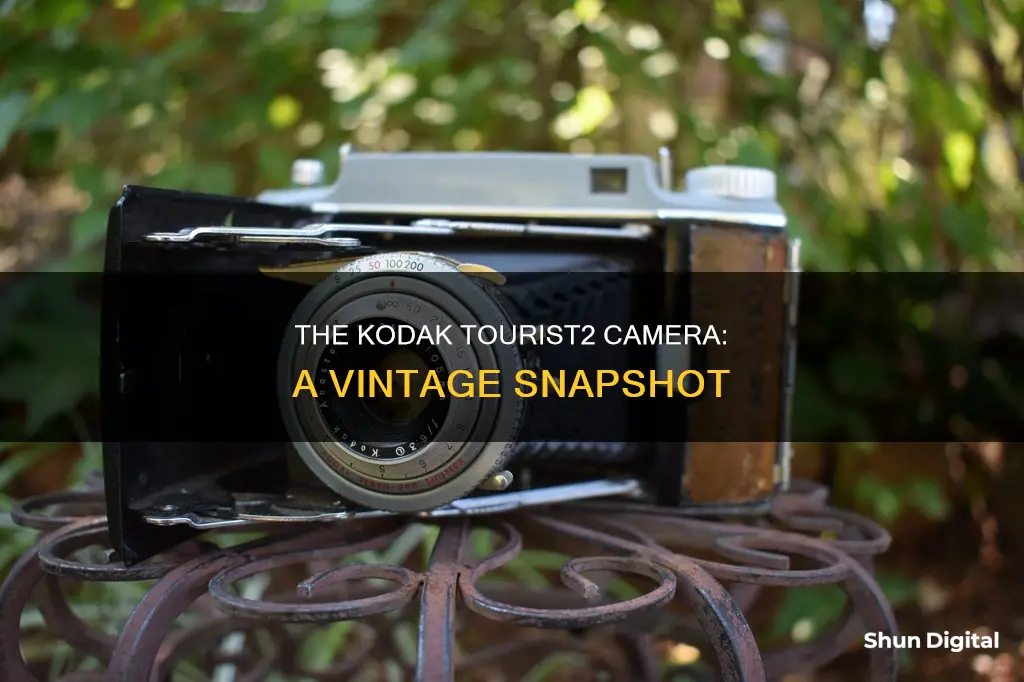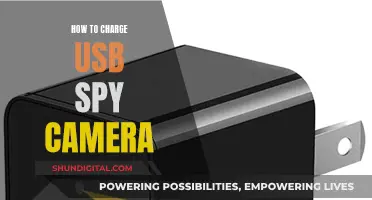
The Kodak Tourist II was introduced in May 1951 as a replacement for the original Tourist series, which was launched in 1948. The Tourist II featured a redesigned top cover and a new viewfinder, and was in production until July 1958.
What You'll Learn

The Kodak Tourist II was introduced in May 1951
The Kodak Tourist II was one of the last American-made folding roll film cameras from Eastman Kodak. The original Tourist series was introduced in 1948 and included a range of quality levels at different price points. The Tourist II, however, featured a redesigned top cover that was expanded and appeared to be designed for a possible integrated rangefinder addition, although this never came to fruition.
The Kodak Tourist II offered a variety of lenses, with the top-end being the Anastar lens, which retailed for $95. The camera had a grey bakelite top with a simple eye-level viewfinder. The viewfinder was fairly accurate, despite its incredibly small size of only about 1/4" across. The film advance knob was made of aluminium and, although it had a generous diameter, it was not very tall, making it difficult to use compared to similar cameras.
The front of the camera featured a small silver button that released the door, which, when pulled, extended the bellows until it locked firmly in place. A button mounted on the door actuated the shutter at the front of the bellows, making the Kodak Tourist II extremely easy to shoot with. The camera had a Flash Kodon shutter with a fixed 1/50th-second shutter speed, and the Kodet Lens offered f/12.5, f/16, f/22, and f/32 apertures.
The Kodak Tourist II was a well-made camera with a die-cast aluminium body covered in black Kodadur, a synthetic leather known for its remarkable durability. All models featured a tripod socket, a lens door-mounted shutter release, eye-level viewfinders, and flash synchronisation. The Anaston and Anastar lens models included cable release sockets on the shutter, front-element focusing, and top-mounted accessory shoes, while the fixed-focus Kodet lens models lacked these features and had smaller viewfinders. Frame spacing and shutter cocking were completely manual on all models.
The Raw Camera Filter: Where Did It Go?
You may want to see also

The camera features a redesigned top cover and a new viewfinder
The Kodak Tourist II, introduced in May 1951, was an update to the original Kodak Tourist series of folding roll-film cameras. The Tourist II featured a redesigned top cover and a new viewfinder, marking a departure from its predecessor.
The redesigned top cover on the Tourist II stood out for its expanded form, which suggested the possibility of integrating a rangefinder—although this addition never came to fruition. This new design feature, however, hinted at Kodak's forward-thinking approach to camera development and their intention to cater to evolving user needs. The top cover's expansion also contributed to the camera's overall aesthetics, giving it a distinct look that set it apart from other cameras of its time.
The new viewfinder was a significant upgrade, as it contained frame lines for the optional 828 roll film adapter. This feature allowed photographers to compose their shots more effectively, especially when using the 828 roll film. The viewfinder's functionality and adaptability made the Tourist II a versatile camera, capable of accommodating different film formats and providing users with a more dynamic photography experience.
The Tourist II maintained the series' reputation for exceptional craftsmanship, featuring a die-cast aluminium body covered in black Kodadur, a durable synthetic leather. This combination of materials ensured the camera's longevity and ability to withstand the rigours of frequent use. The Tourist II also retained the series' trademark tripod socket, lens door-mounted shutter release, and eye-level viewfinders.
The Kodak Tourist II offered a range of lens and shutter combinations, catering to photographers of varying skill levels and budgets. At the lower end, the camera was comparable to a basic box camera, while the higher-end models, such as those equipped with the Anastar lens, were capable of delivering professional-level results.
The Kodak Tourist II, with its redesigned top cover and new viewfinder, exemplified Kodak's commitment to innovation and their desire to provide photographers with enhanced functionality and adaptability. This camera, produced from 1951 to 1958, remains a testament to Kodak's enduring legacy in the world of photography.
Are Camera Batteries Charged? Understanding Camera Battery Basics
You may want to see also

Production was discontinued in July 1958
The Kodak Tourist II was introduced in May 1951, but its production was short-lived. Despite being a popular alternative to more expensive German folding cameras, the Kodak Tourist II production was discontinued in July 1958, just seven years after its initial launch. This discontinuation may have been due to the emergence of new camera technologies or shifting consumer preferences. It is also worth noting that the Kodak Tourist II was the last in a long line of American-made folding roll film cameras from Eastman Kodak.
The Kodak Tourist II's production run saw the camera gain recognition for its unique features and capabilities. One of its most notable attributes was its back, which could be opened on either the left or right side or removed entirely thanks to cleverly engineered latches. This design allowed for the use of the multi-format Kodak Tourist Adapter Kit, providing photographers with additional format and lens options. The camera was also known for its sturdy construction, featuring a die-cast aluminium body covered in black Kodadur, a durable synthetic leather.
The Kodak Tourist II offered a range of lens and shutter combinations, catering to different budgets and skill levels. At the lower end, the camera was comparable to a basic box camera, while the higher-end models, such as those equipped with the Anaston or Anastar lenses, were capable of delivering professional-level results. The Anaston and Anastar lens models also included additional features such as cable release sockets, front-element focusing, and top-mounted accessory shoes.
The Kodak Tourist II played a significant role in the history of photography and remains a sought-after item for collectors and photography enthusiasts. Despite its discontinuation in July 1958, it continues to be recognised for its impact on the industry and the flexibility it offered photographers during its time.
Mastering Camera Modes: AV vs TV Settings
You may want to see also

The Kodak Tourist II takes 620 film
The Kodak Tourist II is a 620 film camera, first introduced in May 1951, and discontinued in July 1958. The Tourist II was an update on the original Kodak Tourist, which was released in 1948. The Kodak Tourist II features a redesigned top cover and a new viewfinder, which contains frame lines for the optional 828 roll film adapter. The Tourist II was offered with a variety of lenses, with the top-end being the Anastar lens, which retailed for $95. The camera body is made from die-cast aluminium, covered in black "Kodadur", a synthetic leather known for its durability. The Kodak Tourist II is also known for its unusual back feature, which can be opened on either the left or right side, or removed completely. This allows for the use of the multi-format Kodak Tourist Adapter Kit, which offers three additional formats: "Square" (2¼×2¼ inch / 6×6 cm on 620 film), "Half 620" (2¼×1⅝ inch / 6×4.5 cm on 620 film), and "828" (28×40mm on 828 film).
The 620 film used in the Kodak Tourist II camera creates eight 2¼×3¼ inch (6×9 cm) exposures. The film is advanced manually using a knob, and the camera features a shutter release mounted on the lens door. The Kodak Tourist II also has an eye-level viewfinder, which some users have noted as being very small and difficult to use. The camera has a grey bakelite top and a simple, telescopic viewfinder. The front of the camera features a small silver button that releases the door, which extends the bellows and locks firmly in place. The shutter is then easily activated by a button mounted on the door.
The Kodak Tourist II is a well-made, sturdy, yet lightweight camera. It is easy to operate, with a simple shutter release mechanism and manual film advance. The large negatives produced by the 620 film also allow for good-quality prints. However, one of the main cons of the camera is the difficulty in advancing the film, as the knob is quite small and awkward to use. Additionally, the 620 film is no longer commonly available, so users may need to re-roll 120 film onto 620 spools, which can be tedious.
The Kodak Tourist II is a good choice for photographers looking for a lightweight, easy-to-use camera that produces high-quality negatives. While it may not be the most desirable camera for collectors, it is a good option for those who want a simple, functional camera for everyday use. The ability to use different film formats with the adapter kit also makes it a versatile option for photographers who want to experiment with different image sizes.
Mastering Night Portrait Mode: Camera Setting Explained
You may want to see also

The camera has a variety of lens/shutter combinations
The Kodak Tourist II, introduced in May 1951, features a range of lens/shutter combinations. The camera's lens/shutter combinations represent a wide range of prices, with the low-end model being a simple folding camera, and the high-end model capable of producing professional-level results.
The Kodet version of the camera, with a single-element meniscus lens and a Flash Kodon shutter, was available for as little as $24.50. This model has a fixed focus 86mm f/12.5 lens and a shutter speed of approximately 1/50 seconds, with bulb and time settings also available.
The Kodak Anaston lens models, on the other hand, offer a range of different lenses and shutters. The Anaston 100mm f/8.8 lens, for example, features a Flash Diomatic shutter with a speed range of 1/25 to 1/100 seconds, plus bulb and time settings. This lens/shutter combination was not available on the Tourist II model. The Anaston 105mm f/6.3 lens was available with either a Flash Diomatic shutter (1/25 - 1/100 seconds) or a Flash 200 shutter (1/25 - 1/200 seconds), both with bulb and time settings.
For those seeking even more advanced features, the Kodak Anaston 105mm f/4.5 lens offered two shutter options: the Flash Kodamatic shutter (1/10 - 1/200 seconds, bulb and time) or the Synchro 400 shutter (1/5 - 1/400 seconds, bulb), the latter of which was a new addition to the Tourist II line. With these lenses, the camera becomes a mild telephoto, suitable for portraiture and wildlife photography.
At the highest end of the range is the Kodak Anastar lens, a four-element Tessar type lens. When paired with the Synchro-Rapid shutter (1/800 seconds, bulb), this combination sold for $95 and was capable of producing professional-level results.
Replacing Sanyo Camera Battery: Step-by-Step Guide
You may want to see also
Frequently asked questions
The Kodak Tourist II was introduced in May 1951 and production was discontinued in July 1958.
The Kodak Tourist II is a 6x9 folding camera that takes 620 film and makes eight 2¼×3¼ exposures. It features a redesigned top cover and a new viewfinder, which contains frame lines for the optional 828 roll film adapter. The camera has a die-cast aluminum body covered in black Kodadur, a synthetic leather of remarkable durability. All models feature a tripod socket, a lens door-mounted shutter release, eye-level viewfinders, and flash synchronization.
The Kodak Tourist was introduced in 1948 and was replaced by the Tourist II in 1951. The Tourist II features a redesigned top cover and a new viewfinder, while the original Tourist has a removable double-hinged film door to support an 828 film back for shooting small format film. The Tourist II also dropped the f/8.8 model and added a higher-end model with a Synchro 400 shutter.







